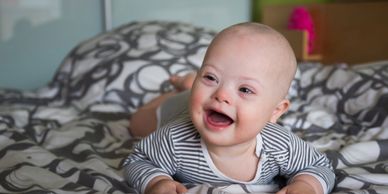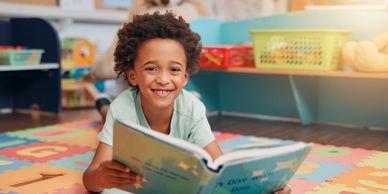Speech and Language Milestones
0 to 3 months
6 to 12 months
3 to 6 months

* Begins to turn head toward sounds
* Quiets or smiles in response to a caregiver’s voice or touch
* Makes eye contact and watches faces intently
* Makes sounds back and forth during interactions
* Starts to imitate facial expressions (e.g., sticking out tongue)
* Cries differently for different needs (e.g., hunger vs. discomfort)
* Coos with vowel-like sounds such as “ooo” or “aahh”
* Recognizes familiar voices and everyday sounds
* Turns head toward voices or people speaking
3 to 6 months
6 to 12 months
3 to 6 months

* Smiles and laughs in response to people
* Initiates social engagement by smiling, cooing, or reaching
* Looks at people’s faces while they speak
* Turns toward voices and sounds
* Enjoys interactive games like peekaboo and tickling
* Follows interesting objects with their eyes
* Reacts to noisy toys or sounds
* Coos, gurgles, and babbles with increasing variety
* Begins combining vowel and consonant sounds (e.g., “ba,” “da,” "ma")
* Blows “raspberries” or bubbles with their lips
6 to 12 months
6 to 12 months
12 to 18 months

* Uses vocalizations to express excitement, frustration, or attention-seeking
* Looks toward caregiver when their name is called
* Waves “hi” or “bye”, claps, and points to show interest
* Pauses or stops when told “no”
* Babbles in longer strings like “mamama” or “babababa”
* Seeks comfort from familiar people when upset
* Uses gestures like pointing, waving, or showing objects
* Tries to imitate sounds / syllables / words
* Understands simple phrases like “Go bye-bye” or “Look at Mommy”
* Says one or two meaningful words or word approximations by 12 months
12 to 18 months
12 to 18 months
12 to 18 months

* Says 5–10 words clearly and meaningfully
* Uses words to name familiar people or objects (e.g., “Mama,” “ball”)
* Follows simple one-step directions (e.g., “Give me the toy”)
* Responds to their name and simple social cues (e.g., “bye-bye”)
* Points to body parts when asked (e.g., “Where’s your nose?”)
* Uses gestures and words together (e.g., saying “up” while reaching)
* Repeats words they hear in conversation
* Enjoys songs, stories, and rhymes
* Understands more words than they can say
* Tries to communicate wants and needs using sounds, words, or gestures
* Looks to adults for cues in unfamiliar situations (social referencing)
18 to 24 months
12 to 18 months
18 to 24 months

* Says at least 50 words by age 2
* Begins putting two words together (e.g., “more juice,” “go car”)
* Asks simple questions using one or two words (e.g., “What’s that?”)
* Follows two-step directions (e.g., “Get your shoes and bring them here”)
* Names common objects, people, and actions
* Uses words to express wants and needs more clearly
* Uses words to protest (“no!”), request (“want ball”), or greet (“hi,” “bye”)
* Imitates new words and phrases they hear
* Begins to use pronouns like “me” and “you”
* Enjoys pretend play with toys (e.g., feeding a doll, driving a car)
* Understands simple concepts like “in,” “on,” and “under”
* Enjoys playing near and with others (parallel play)
* Shows interest in peers, may imitate or try to communicate with them
2 to 3 years
12 to 18 months
18 to 24 months

* Uses 2–4 word phrases consistently (e.g., “I want milk,” “Daddy go work”)
* Vocabulary grows to 200+ words by age 3
* Begins using simple sentences
* Asks and answers simple questions (e.g., “What’s that?”, “Where’s Mommy?”)
* Follows 2–3 step directions (e.g., “Pick up the toy and put it in the box”)
* Uses pronouns correctly (e.g., “I,” “me,” “you”)
* Begins to understand concepts like big/small, up/down
* Speech is becoming clearer—familiar adults understand most of what they say
* Enjoys listening to stories and may ask for favorites repeatedly
* May say untrue things to avoid trouble, but without fully understanding the difference between truth and lies (more confusion or wishful thinking than intentional deception)
3 to 4 years
5 to 6 + years
3 to 4 years

* Speaks in full sentences (4+ words) and tells simple stories
* Uses 500–1,000 words or more by age 4
* Asks lots of questions: “Why?”, “Who?”, “Where?”
* Understands and uses past tense (e.g., “I went to the park.”)
* Follows multi-step directions (e.g., put on your shoes and go to the door)
* Talks about things that happened in the recent past
* Begins to use syntax (sentence structures) correctly—plurals, pronouns, and simple verb tenses
* Speech is mostly understood by people outside the family
* Takes 3-4 turns in conversation and stays on topic
* Initiates conversation with familiar adults and peers
* Starts to understand and use polite words such as “please” and “thank you” (with reminders)
* Enjoys rhyming, singing, and pretend play with dialogue
* Begins to tell deliberate lies, mostly to avoid punishment or get something they want
* Starts to understand that others have different thoughts and perspectives (the beginnings of theory of mind)
4 to 5 years
5 to 6 + years
3 to 4 years

* Speaks in detailed sentences with 5+ words
* Tells simple stories with a clear beginning, middle, and end
* Uses future tense (e.g., “We will go to the zoo tomorrow.”)
* Understands time-related concepts like today, tomorrow, and yesterday
* Follows complex directions with multiple steps, without needing repetition
* Names letters, numbers, and shapes
* Uses most syntax rules correctly (plurals, possessives, tenses)
* Can answer “why” and “how” questions
* Speech is clear and easily understood by both familiar and unfamiliar listeners
* Engages in back-and-forth conversation, taking turns and asking questions
* Stays on topic for several exchanges
* Begins using language to express opinions, share ideas, and tell simple stories
* Shows interest in other children and starts engaging in cooperative play
* Uses polite language ("please," "thank you") with reminders
5 to 6 + years
5 to 6 + years
5 to 6 + years

5 to 6 Years
* Speaks in grammatically correct sentences
* Describes objects by category or function
* Understands opposites (e.g., big/little, fast/slow)
* Begins to understand humor and figures of speech
* Tells long, detailed stories that stay on topic
* Recognizes and produces rhyming words
* Understands sequencing (first, next, last)
* Speech is clearly understood by all listeners
6 to 8 Years
* Uses advanced vocabulary
* Engages in conversations with appropriate topic shifts and turn-taking
* Understands and uses synonyms, antonyms, and multiple-meaning words
* Starts to explain ideas logically and give reasons
* Retells stories with accurate details and sequence
* Understands jokes, riddles, and simple idioms
* Uses language for reading comprehension and writing
Pediaprogress
1101 W. 31st ST suite 110 Downers Grove, IL 60515 | limited availability for Early intervention home visits in lombard, westmont, lemont, lockport, woodridge, wheaton, glen ellyn, darien, lisle, Naperville, oak brook, oak brook terrace
.jpg/:/rs=h:104,cg:true,m/qt=q:95)